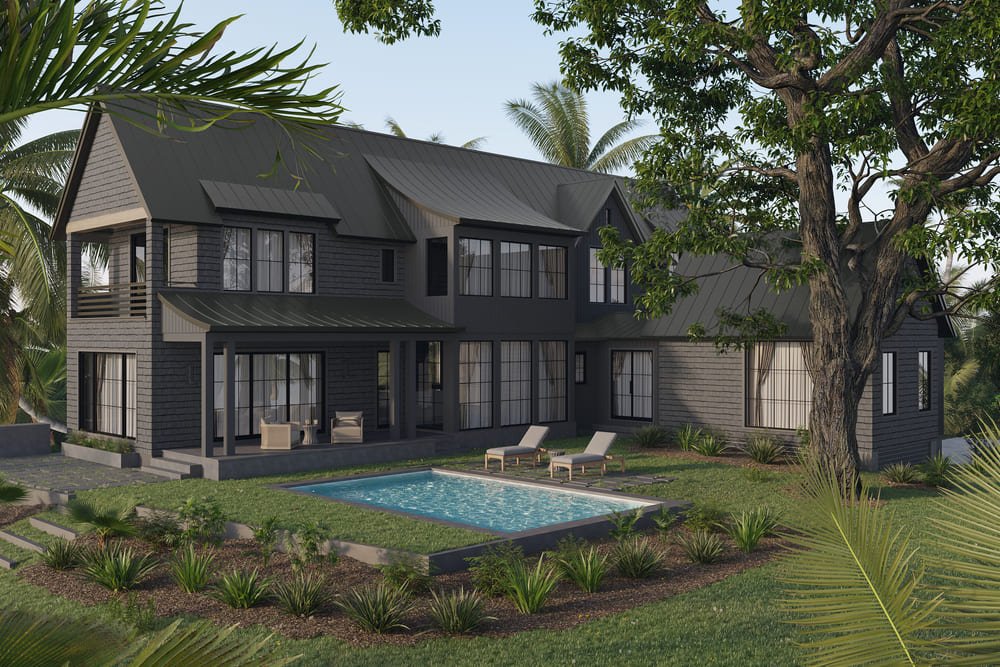Increasing Sales: The Power of 3D Exterior Rendering in Real Estate
In the fast-paced and highly competitive world of real estate, making a lasting impression is crucial. As prospective buyers scroll through property listings online or drive through neighborhoods, the visual impact of a property often captures their attention and prompts further interest. Real estate professionals understand that stunning visuals can be the key to unlocking a property’s full potential. This is where the transformative power of 3D exterior rendering comes into play.
In this comprehensive guide, we’ll journey through 3D exterior rendering in real estate. We’ll uncover how this cutting-edge technology changes the game, from attracting more buyers to increasing sales prices. Whether you’re a real estate agent, developer, or simply interested in the evolving world of real estate marketing, this article will shed light on how 3D exterior rendering is revolutionizing the industry.
The Visual Revolution in Real Estate

The Impact of Visuals in Real Estate: In the digital age, visuals have become the primary currency of communication. This is especially true in the real estate sector. When a potential buyer first encounters a property listing, the images and visuals pique their interest. In fact, according to a study by the National Association of Realtors, over 90% of home buyers begin their search online, and the quality of listing photos is paramount.
Real estate professionals have long relied on high-quality photographs to showcase properties, but 3D exterior rendering takes visual representation to an entirely new level. With photorealistic 3D renders, potential buyers can explore a property in intricate detail before scheduling a physical visit. This not only saves time for both buyers and sellers but also opens up new possibilities for marketing properties.
The Rise of 3D Exterior Rendering: Traditionally, property listings relied on photographs that, while visually appealing, could only capture the property from a fixed perspective. This limitation often left buyers wanting a more comprehensive view of the property, an understanding of its spatial layout, and the ability to visualize its future. This traditional real estate marketing gap is where 3D exterior rendering steps in.
3D exterior rendering employs cutting-edge technology and skilled craftsmanship to create lifelike, three-dimensional representations of properties. These renders give viewers the sensation of standing in front of the property, exploring it from various angles, and even “walking” through it. They can showcase a property’s exterior, landscaping, and surrounding environment with impeccable detail and realism.
The Psychological Impact: Beyond the technical marvel, there’s a profound psychological impact that 3D exterior rendering has on potential buyers. The emotional connection deepens when individuals can visualize themselves living in a space. This emotional resonance can be a powerful motivator in the decision-making process.
Imagine a prospective homebuyer scrolling through listings and stumbling upon a property with exceptional 3D renders. As they virtually tour the property, they begin to imagine their life within it—their morning routines, family gatherings, and personal milestones. This emotional attachment can be the catalyst that transforms a casual browser into a motivated buyer.
The Advantages of 3D Exterior Rendering

1. Immersive Virtual Tours: One of the standout advantages of 3D exterior rendering is the ability to offer immersive virtual tours. These tours allow potential buyers to explore a property as if they were physically present. They can “walk” through the garden, step onto the patio, and even experience the view from the backyard. This level of interactivity is unparalleled in traditional real estate marketing.
2. Enhanced Presentation: 3D exterior rendering enables properties to be presented in their best light, regardless of the season or weather conditions. For instance, a property can be showcased under clear blue skies, even if the photo shoot occurred on an overcast day. The ability to present properties at their most appealing is a significant advantage for real estate professionals.
3. Off-Plan Visualization: In the case of new developments, 3D exterior rendering allows potential buyers to visualize the property even before construction begins. Developers can create compelling visuals of planned projects, giving buyers the confidence to invest in properties that may not yet exist physically. This off-plan visualization opens up exciting opportunities for pre-sales.
4. Versatility in Marketing: 3D renders are incredibly versatile marketing assets. They can be used across various platforms, from websites and social media to brochures and presentations. This versatility ensures the property is presented consistently and attractively across all marketing channels.
5. Cost-Effective: While 3D exterior rendering represents a high level of sophistication, it can be a cost-effective solution for real estate professionals. Compared to traditional methods that may involve expensive staging, professional photography, and time-consuming photo shoots, 3D rendering offers a streamlined and cost-efficient alternative.
The Impact on Sales: How 3D Exterior Rendering Revolutionizes Real Estate
The ultimate goal in the fiercely competitive real estate market is to close deals swiftly and at the best possible price. While the initial introduction of a property plays a significant role in attracting potential buyers, the real test is whether that interest converts into sales. In this section, we’ll delve into the tangible impact of 3D exterior rendering on real estate sales, exploring how it influences buyer behavior, increases property values, and streamlines the sales process.
Transforming Buyer Behavior
1. Increased Engagement: The journey from a casual online property browser to a committed buyer is often marked by engagement. The more engaged a potential buyer is with a property listing, the higher the likelihood of a successful sale. 3D exterior rendering elevates engagement levels by providing an immersive and interactive experience.
When buyers can virtually explore a property from their computer or mobile device, they’re more likely to engage with the listing. They can navigate the property, examining it from different angles and getting a feel for the layout. This increased engagement translates to a deeper connection with the property.
2. Emotional Attachment: As mentioned earlier, creating emotional connections potentiates real estate sales. High-quality 3D renders go beyond showcasing a property; they tell a story. Buyers can envision their lives within the space, and this emotional attachment can be the impetus for making an offer.
Imagine a family viewing a 3D-rendered property with a beautifully landscaped backyard, perfect for hosting barbecues and creating cherished memories. The emotional resonance of imagining their children playing in the garden can be the pivotal moment that leads to a property showing request.
Increasing Property Values
1. Perception of Value: 3D exterior rendering can remarkably elevate a property’s perceived value. When potential buyers are presented with a visually stunning and immersive representation of a home, they’re more likely to perceive it as a valuable investment. This perception of value can result in more competitive offers.
2. Highlighting Unique Features: Every property has unique selling points, whether it’s a captivating view, a spacious backyard, or architectural details. 3D rendering allows real estate professionals to emphasize these features effectively. For instance, a property with an ocean view can be showcased at sunset, with the virtual sun casting a warm glow over the scene. This highlights the unique feature and makes the property more appealing.
3. Competitive Edge: In a crowded marketplace, standing out is crucial. Properties with exceptional 3D renders gain a significant competitive edge. They capture the attention of potential buyers and can often command higher asking prices. When buyers perceive a property as unique and valuable, they are more willing to make competitive offers.
Streamlining the Sales Process
1. Fewer Unqualified Inquiries: 3D exterior rendering can help filter out unqualified buyers. Potential buyers can gain a comprehensive understanding of the property when they have access to detailed 3D tours and high-quality renders. This means that they are more likely to be genuinely interested and financially qualified when they reach out to schedule a physical viewing.
2. Faster Decision-Making: The traditional process of viewing multiple properties can be time-consuming. Buyers often need to schedule appointments, travel to different locations, and dedicate significant hours to property visits. 3D exterior rendering streamlines this process by allowing buyers to narrow their choices from the comfort of their homes.
Buyers can virtually visit multiple properties in a shorter time frame, allowing them to make faster decisions. This efficiency benefits both buyers and sellers by expediting the sales process.
3. Confidence in Purchase: When buyers have thoroughly explored a property through 3D exterior rendering, they enter physical viewings confidently. They’ve already visualized themselves in the space, and the physical viewing becomes an opportunity to validate their impressions. This confidence often leads to quicker purchase decisions.
The Ripple Effect: Agents, Developers, and Buyers
It’s essential to recognize that the influence of 3D exterior rendering in real estate extends beyond the buyer-seller relationship. It has a ripple effect that impacts various stakeholders in the industry.
1. Real Estate Agents: For real estate agents, 3D exterior rendering enhances their ability to market properties effectively. It allows them to present properties in the best possible light, attract more qualified buyers, and close deals more efficiently. This benefits their clients and strengthens their reputation as top-tier professionals.
2. Developers: Developers can harness the power of 3D exterior rendering to market new projects well before construction is completed. This pre-sale approach can significantly impact a project’s success by securing prior commitments from buyers.
3. Buyers: Buyers benefit from 3D exterior rendering by understanding properties comprehensively before committing to viewings. This saves time, reduces frustration, and enables more informed decisions.
The Future of Real Estate Marketing: Advancements in 3D Exterior Rendering
The journey of 3D exterior rendering in real estate has been remarkable, revolutionizing how properties are marketed and sold. As technology continues to evolve rapidly, it’s exciting to contemplate the future of this transformative tool and the innovations that lie ahead.
Embracing Augmented and Virtual Reality (AR/VR)
The integration of augmented reality (AR) and virtual reality (VR) is set to be a game-changer in real estate marketing. These immersive technologies will enable potential buyers to experience properties in ways we can only dream of today.
Imagine putting on a VR headset and stepping into a 3D-rendered property as if you were physically there. You can explore every room, inspect details, and even understand the neighborhood. AR will take this a step further, allowing potential buyers to use their smartphones or AR glasses to superimpose 3D-rendered models of properties onto the real world. This means you can view the property from the sidewalk or stand in an empty room, seeing how your furniture might fit.
Personalized and Interactive Experiences
Future 3D exterior rendering will prioritize personalization and interactivity. Buyers will be able to customize aspects of a property, from the color of the walls to the furniture style. These interactive experiences create a more profound sense of ownership and emotional attachment.
Furthermore, AI-driven technology will enable virtual property tours that adapt to the preferences of individual buyers. If a buyer prefers modern kitchens during their virtual tour, the rendering can automatically adjust to showcase more properties with modern kitchen designs.
Seamless Integration with E-commerce Platforms
The convenience of online shopping has extended to real estate, and 3D exterior rendering will seamlessly integrate with e-commerce platforms. Buyers will explore properties and have the option to purchase them directly through these platforms. This means that the entire buying process can happen online, from viewing a 3D-rendered property to signing contracts.
Environmental Considerations
As sustainability becomes an increasingly important factor in real estate, 3D rendering will play a role in showcasing environmentally friendly features. Buyers can explore properties with renewable energy sources, energy-efficient designs, and sustainable materials, helping them make informed choices that align with their environmental values.
Global Accessibility
The global reach of 3D exterior rendering is set to expand further. International buyers can explore properties remotely, which can be especially valuable for those investing in properties abroad. The ability to virtually tour properties in different countries will become a standard feature, making cross-border real estate transactions more accessible.
Conclusion: A Bright Future Ahead
The impact of 3D exterior rendering on the real estate industry is undeniable. It has transformed how properties are marketed and sold, influencing buyer behavior, increasing property values, and streamlining the sales process. This transformative technology has benefited buyers, sellers, real estate agents, developers, and the industry.
As we gaze into the future, it’s clear that 3D exterior rendering will continue to evolve, embracing AR, VR, personalization, and environmental considerations. It will become an integral part of the real estate ecosystem, making the buying and selling of properties more efficient, immersive, and accessible on a global scale.
In this ever-evolving landscape, one thing remains constant: the power of 3D exterior rendering to captivate imaginations, tell compelling stories, and transform how we envision and experience the world of real estate.
